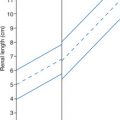Chapter 8. Bowel
Patient Preparation
• Fasting for 6 to 8 hours before the examination(s) is preferable, but it may be accomplished without preparation.
Equipment and Technical Factors
• A curved linear or linear array (thin patient) is the transducer of choice.
Imaging Protocol
• Longitudinal and transverse axes images should be the area of interest
• To avoid confusion as a result of the variety transducer placements that may be used to obtain diagnostic images of the area of interest, each image must be labeled accurately for scan plane and anatomy demonstrated.
• Normal bowel should demonstrate peristalsis and movement of fluid through the lumen.
• The graded compression technique is used to differentiate normal versus abnormal bowel.
Sonographic Measurements
• Bowel diameter: <5.0 mm
• Appendix: <6.0 mm in diameter, <2.0 mm in wall thickness
| Bowel | |||
|---|---|---|---|
| Sonographic Finding(s) | Clinical Presentation | Differential Diagnosis | Next Step |
Appearance of a “kidney” in the abdomen (pseudokidney sign) “Mass” with hyperechoic center with surrounding hypoechoic layer (target sign) “Mass” does not compress with transducer pressure Decreased peristalsis may be noted | Asymptomatic May have bowel complaints: Cramping Nausea Vomiting Weight loss May have pain at site Anemia and palpable mass associated with lymphoma Stay updated, free articles. Join our Telegram channel
Full access? Get Clinical Tree


| ||

